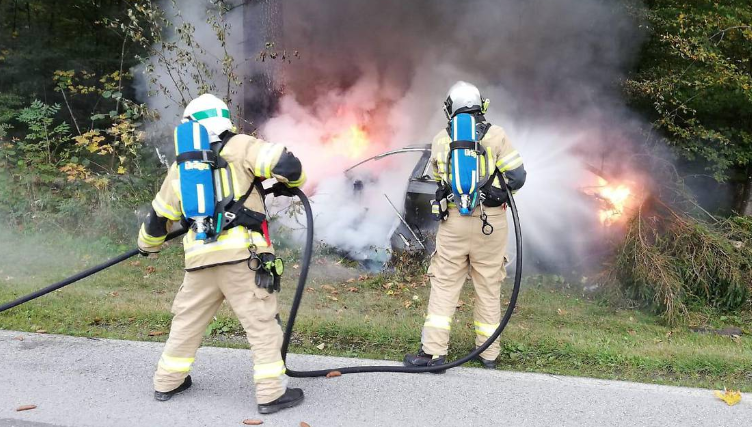The National Highway Traffic Safety Administration is investigating the crash of a speeding Tesla that killed two people in a Los Angeles suburb, the agency announced Tuesday.
Agency spokesman Sean Rushton wouldn’t say whether the Tesla Model S was on Autopilot when it crashed on Dec. 29 in Gardena. That system is designed to automatically change lanes and keep a safe distance from other vehicles.
The black Tesla had left a freeway and was moving at a high rate of speed when it ran a red light and slammed into a Honda Civic at an intersection, police said.NHTSA investigating fatal California Tesla crash
A man and woman in the Civic died at the scene.
Another Tesla crash killed a woman Sunday in Indiana. State police said the driver, Derrick N. Monet, 25, of Prescott Valley, Arizona, was seriously injured after he rear-ended a fire truck parked along Interstate 70 in Putnam County. His wife, Jenna N. Monet, 23, was pronounced dead at a hospital.
Folks, Tesla’s Autopilot is starting to attract the attention of regulators and I suspect the lawyers will soon follow. It will be curious how the company responds when it finally gets held to the same standards as other automakers.
NHTSA … has inspected a total of 13 crashes involving Tesla vehicles that the agency believed were operating on the Autopilot system. Results were published in two of those cases, one of which involved Autopilot. Results are pending in the other 10 cases, the agency said in a statement.
Not only is the Autopilot system being looked at for deaths, but a lawsuit in Florida is underway concerning the vehicle’s door design. The door handles retract into the door. A Tesla involved in a crash resulted in the driver’s door failing to open because electrical power was lost in the vehicle. This resulted in failed rescue attempts to save the driver while the vehicle burned.
Omar Awan was driving his dream car when he lost control. The sleek, blue Model S Tesla careened across a road in South Florida and slammed into a palm tree.
But it wasn’t the crash that killed him, his family’s lawyers said — it was the car’s futuristic design features.
The last moments of Awan’s life were gruesome and excruciating. After the crash, the Tesla’s lithium ion battery caught fire, according to a wrongful-death lawsuit. Smoke — and then flames — filled the car, suffocating Awan and burning him from his feet up. Outside, a crowd gathered but couldn’t help.
That’s because the car’s retractable door handles, which are supposed to “auto-present” when they detect a key fob nearby, malfunctioned and first responders weren’t able to open the doors and save Awan, the suit alleges.A man died in a burning Tesla because its futuristic doors wouldn’t open, lawsuit alleges
“The fire engulfed the car and burned Dr. Awan beyond recognition — all because the Model S has inaccessible door handles, no other way to open the doors, and an unreasonably dangerous fire risk,” the complaint reads.
Awan’s death is one in a string of recent incidents that have been blamed on Tesla’s innovative technology. A lawsuit stemming from a May 2018 crash that killed two teens also blamed a battery fire for at least one of the deaths.
In Awan’s case and others, the carmaker has argued that high-speed crashes can result in fires whether the car is powered by gasoline or batteries. But Awan survived the crash, and he could have escaped the smoke and fire, too, Grossman said — if only the police officer who arrived on the scene could have opened the car’s doors.
The lawsuit asserts that the features rendered the car “defective” and “dangerous” — the door handles compounding the problem of an “inherently unstable” battery.
“Tesla failed to warn users about the scope and extent of the defective and unreasonably dangerous conditions of the Model S,” the complaint says.
The Broward County autopsy report, obtained by The Washington Post, lists Awan’s cause of death as “inhalation of products of combustion with a contributory cause of death of thermal injuries.”
The medical examiner who responded to the crash wrote that Awan “was not identifiable on scene.” His clothes and hair were burned and a yellow metal ring was found on his left ring finger.
Oh, if you recall the article that I posted a few months ago on Tesla fires, the following will be no surprise to you.
After the crash, and after firefighters extinguished the blaze, Awan’s Tesla was transported to a tow yard. Once there, it reignited and burned again.
Yep, reigniting of the vehicle following a fire is typical for Tesla and other electric cars. In the old days, we called this a Class D fire.
Class D fires involve combustible metals – especially alkali metals like lithium and potassium, alkaline earth metals such as magnesium, and group 4 elements such as titanium and zirconium.
Fire class
As attempts at creating self-driving vehicles continue, expect more such news reports of deaths and injuries.
